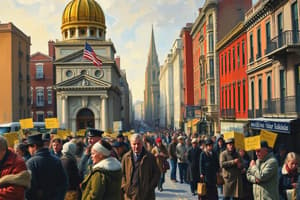Podcast
Questions and Answers
Who arrived in the United States in the first wave of immigration?
Who arrived in the United States in the first wave of immigration?
European colonists
Between the 1600's and the 1980's who immigrated to the United States? Southern Colonists and Eastern Europeans. Ireland and Germany. Mexico and India. Asia and Middle East, and Central. South America.
Between the 1600's and the 1980's who immigrated to the United States? Southern Colonists and Eastern Europeans. Ireland and Germany. Mexico and India. Asia and Middle East, and Central. South America.
Southern Colonists Eastern Europeans Ireland Germany Mexico India Asia Middle East Central South America
After WWII, why did Europeans move to Canada?
After WWII, why did Europeans move to Canada?
They lost their homes
What makes North America and Canada so diverse?
What makes North America and Canada so diverse?
What is an important American value?
What is an important American value?
How did the newspaper provide information during the 1800s?
How did the newspaper provide information during the 1800s?
What did the radio provide during the 1900s?
What did the radio provide during the 1900s?
What did the television provide to people?
What did the television provide to people?
What did cell phones provide to people around the world?
What did cell phones provide to people around the world?
What did the internet provide to people?
What did the internet provide to people?
Why are the economies of the United States and Canada changing?
Why are the economies of the United States and Canada changing?
In the early 1800's, most Americans and Canadians worked in industries in which people make a living directly from the land. Give 4 examples of these industries.
In the early 1800's, most Americans and Canadians worked in industries in which people make a living directly from the land. Give 4 examples of these industries.
Between the 1870's and 1950's The Manufacturing Industry led the economy. What products were being manufactured by workers in factories during this time?
Between the 1870's and 1950's The Manufacturing Industry led the economy. What products were being manufactured by workers in factories during this time?
In the 1950's the service industry began to grow, give examples of 'services'.
In the 1950's the service industry began to grow, give examples of 'services'.
The growing demand for nonrenewable fossil fuels for energy has led to exploration into renewable alternative energy sources.
The growing demand for nonrenewable fossil fuels for energy has led to exploration into renewable alternative energy sources.
List the Energy sources other than oil in the boxes below. Explain the issues that come from each of these alternative sources.
List the Energy sources other than oil in the boxes below. Explain the issues that come from each of these alternative sources.
Flashcards
First wave of US immigration
First wave of US immigration
European colonists arriving in the United States.
US immigration (1600s-1980s)
US immigration (1600s-1980s)
Diversity of groups immigrated, including Europeans, Southern and Eastern Europeans, Mexicans, Asians, and more.
European migration to Canada (post-WWII)
European migration to Canada (post-WWII)
Europeans migrated to Canada after losing their homes due to the war.
North American diversity
North American diversity
Signup and view all the flashcards
American value: tolerance
American value: tolerance
Signup and view all the flashcards
Newspaper role (1800s)
Newspaper role (1800s)
Signup and view all the flashcards
Radio's role (WWII)
Radio's role (WWII)
Signup and view all the flashcards
Television's role
Television's role
Signup and view all the flashcards
Cell phone impact
Cell phone impact
Signup and view all the flashcards
Internet impact
Internet impact
Signup and view all the flashcards
US/Canada changing economies
US/Canada changing economies
Signup and view all the flashcards
Early 1800s US/Canada economy
Early 1800s US/Canada economy
Signup and view all the flashcards
Manufacturing industry (1870s-1950s)
Manufacturing industry (1870s-1950s)
Signup and view all the flashcards
Service industry growth
Service industry growth
Signup and view all the flashcards
Importance of alternative energy
Importance of alternative energy
Signup and view all the flashcards
Nuclear power issues
Nuclear power issues
Signup and view all the flashcards
Ethanol issues
Ethanol issues
Signup and view all the flashcards
Solar power limitations
Solar power limitations
Signup and view all the flashcards
Wind power limitations
Wind power limitations
Signup and view all the flashcards
Study Notes
North America's Cultural Diversity
- The first wave of immigration to the US was European colonists.
- Between the 1600s and 1980s, immigrants from Southern and Eastern Europe, Ireland, Germany, Mexico, India, Asia, the Middle East, and Central and South America came to the US.
- After World War II, some Europeans moved to Canada due to losing their homes.
- The mix of races, languages, religions, and nationalities makes North America and Canada diverse.
- Tolerance and acceptance of different views are important American values.
The Media Culture
- Media technology has changed over time, serving distinct purposes in each era.
- Newspapers in the 1800s provided information and influenced public opinion.
- Radio provided news and entertainment, becoming particularly important during World War II.
- Television served as a significant source of news and entertainment, often providing live footage.
- Cell phones connected people globally, offering internet access.
- The internet provided quick access to vast amounts of information and allowed people to share their own media.
The Changing Economy
- The economies of the US and Canada are evolving due to new technologies and global trends.
- In the early 1800s, most people worked in industries related to extracting resources from the land, including farming, mining, fishing, and logging.
- From the 1870s to 1950s, manufacturing (iron and steel) was the dominant industry.
- By the 1950s, the service industry (entertainment, healthcare, education) grew.
Finding New Energy Sources
- Increasing demand for non-renewable fossil fuels led to exploring alternative energy sources.
- Alternative energy sources include nuclear power, ethanol, solar power, and wind power.
- Nuclear power plants are expensive and create radioactive waste.
- Ethanol production competes with food production from grains.
- Solar and wind power cannot consistently meet demand.
Studying That Suits You
Use AI to generate personalized quizzes and flashcards to suit your learning preferences.



